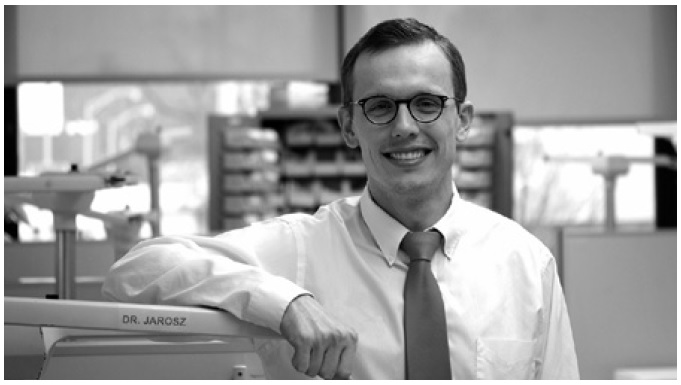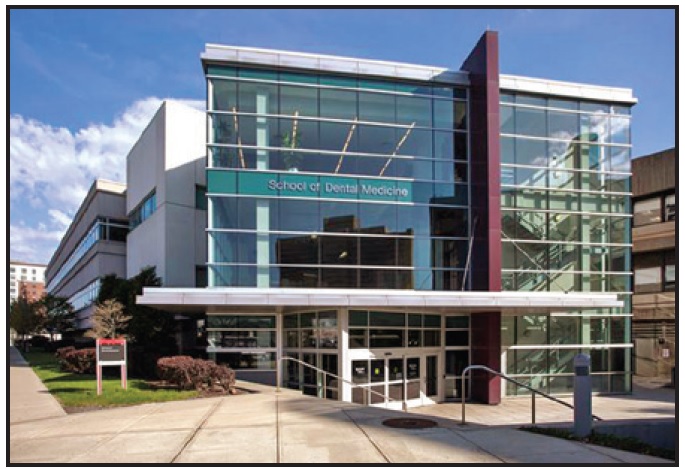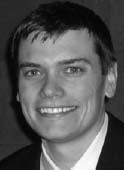2016 Eugene L. Gottlieb JCO Student of the Year: Dr. Krystian Jarosz
The Journal of Clinical Orthodontics is proud to recognize Dr. Krystian Jarosz from Rutgers University as the winner of the inaugural Eugene L. Gottlieb JCO Student of the Year Award, presented by American Orthodontics. Dr. Jarosz was selected over 16 other students from schools around the United States in a competition judged by members of the JCO editorial board. His prize includes more than $8,000 worth of materials and travel from American Orthodontics, JCO, and Dolphin, as well as a presentation ceremony during the AAO annual conference in Orlando, Florida.
The Student of the Year Award is named to honor the legacy of JCO's founding editor, Dr. Gottlieb. The competition was held in two stages. First, any orthodontic department in the United States was allowed to nominate one current student. Each nominee submitted a complete case report, two letters of recommendation, and a personal essay. Three JCO editorial board members narrowed the 17 nominees down to 12 finalists in November. In the second stage, each of the finalists was given the materials from an unpublished case and asked to write a complete treatment plan, including all possible alternatives, within a two-week time frame. Moderated by JCO's Editor, Dr. Robert Keim, the judging panel included Dr. Gayle Glenn of Dallas; Dr. John Graham of Salt Lake City; Dr. Neal Kravitz of South Riding, Virginia; Dr. W. Ronald Redmond of San Clemente, California; Dr. Sarah Shoaf of Winston-Salem, North Carolina; and Dr. Peter Sinclair of Los Angeles.
Congratulations to Dr. Jarosz and Rutgers University! Orthodontic students and faculty should anticipate the start of the 2017 nomination process in August.
PHILIP B. VOGELS, JCO Director of Marketing and Digital Media
Q&A with Dr. Krystian Jarosz
Can you tell us a little about yourself?
I immigrated to the United States from Poland with my parents and older brother when I was 7 years old. I was raised in New Jersey and have a younger brother who was born in the United States. My mother is a real-estate agent, my father is a mechanic, my older brother is an architect, and my younger brother just entered college. I am fluent in Polish and conversant in Spanish. When I am not working, I enjoy spending time with my wife and family and staying active. In particular, I enjoy competitive outdoor and indoor tennis, as well as platform tennis.
Similar articles from the archive:


Rutgers University School of Dental Medicine in Newark, New Jersey (photo courtesy of Rutgers University).
How does it feel to have won the inaugural Eugene L. Gottlieb JCO Student of the Year Award?
I feel incredibly honored to be selected as the recipient. This accomplishment is a testament to the entire orthodontic faculty at Rutgers University, who over the past three years have taught and inspired me to go further. I am blessed to have been surrounded by such talented individuals from whom I have learned so much. I also thank my wife, Maria, as well as my parents, Bohdan and Dorota, for their unwavering support throughout my educational endeavors of becoming an orthodontist. Lastly, congratulations to all the finalists who were selected as candidates for this prestigious award. I hope for all of our careers to be filled with promise, excitement, and continued involvement in the advancement of our wonderful specialty.
Why are you pursuing a career in orthodontics?
This is the specialty that influenced me to pursue a dental education in the first place. As an adolescent, I was treated in the residency program from which I am now graduating. The impact that my orthodontist had on my self-perception and dental health inspired me to pursue training in the most wonderful specialty that dentistry has to offer.
Can you describe the path that led you to Rutgers University?
My path to Rutgers University was unlike that of the typical resident. Throughout dental school, I developed a strong interest in the specialty of oral and maxillofacial surgery, as well as orthodontics. After dental school, I originally pursued surgical training. Less than a year into my formal residency, I decided that this specialty was not the right fit for me. I then worked as an associate general dentist in a number of offices prior to reapplying to residency - this time in orthodontics. I believe that my surgical training, as well as my private-practice experience, has helped in developing my unique approach and understanding of interdisciplinary orthodontic treatment.
What has surprised you the most during your orthodontic education?
In mathematics, there are multiple ways of solving the same problem. Similarly, in our specialty, there is often more than one way to treat a patient to achieve a predictable and stable result. Whether it is with different extraction patterns, bracket systems, removable or fixed appliances, or clear aligners, the variety of treatment approaches is one of the most surprising and interesting aspects of our specialty.
What has been the most difficult part of becoming an orthodontist?
Prior to beginning my orthodontics residency, I worked full-time in private practice as a general dentist. Ever since I entered residency, my wife has been the only one supporting both of us financially. With our first baby on the way, I am looking forward to graduating and finally helping her support our growing family.
What, so far, has been your most rewarding orthodontic experience?
I see this as a tie between having my braces removed after completing orthodontic treatment as an adolescent and debonding my first ABO patient during my third year of residency. As a patient, I received Phase I treatment with a 2 x 4 appliance and cervical-pull headgear, then Phase II comprehensive care. My total treatment time was approximately three and a half years. Debonding of my first ABO patient was equally rewarding, but this time I was the care provider. The level of my patient's enthusiasm following appliance removal reminded me of myself when I was in her shoes. At that moment, I felt like I had come full circle.
What has been your most difficult residential case?
My most difficult case as a resident is also my most rewarding. A timid 15-year-old boy presented with bimaxillary protrusion and significant caries in three of his four first molars. The remaining upper first molar had a large restoration. The treatment plan was to extract all the first molars and replace them with the second molars, replace the second molars with third molars, and reduce the bimaxillary prognathism by retracting the anterior dentition. The patient's treatment was progressing very well when, in the middle of his treatment, he was assaulted in his community, resulting in a skeletal dentoalveolar fracture of his mandible.
The patient's mouth was wired shut by his oral surgeon for a number of weeks until his mandible healed. Thankfully, he did not have any significant soft-tissue trauma or inferior alveolar or lingual nerve injury. He was also lucky to not have any pulpal repercussions of the affected teeth. The incident set his treatment back a number of months, but I was able to bring the patient's progress back on track.
Needless to say, through this case I gained valuable insight into some advanced treatment mechanics. The case also made me greatly appreciate the well-being of this patient, whose compliance was second to none during the entire process. He is, likewise, most appreciative of my efforts to provide him with the best orthodontic care that I could.
Any research projects you'd like to briefly share with our readers?
My master's thesis focuses on assessing the perception of facial asymmetries as compared between lay persons, general dentists, and orthodontists. The survey has already been distributed online with the assistance of the AAO and the New Jersey Dental Association, along with lay persons from the Rutgers School of Dental Medicine. We are hoping to publish the study in a major journal soon.
What are your postgraduate plans?
Personally, my wife and I are waiting with tremendous joy to welcome our first baby in June of this year, one month after my graduation from orthodontics residency. Professionally, my goal is to begin working as an equity-minded associate in order to join an established orthodontic practice in New Jersey. When the time is right, I will return to academia on a part-time basis, as teaching is one of my many interests.
What do you think orthodontics will look like in 10 years?
The orthodontic specialty will continue to evolve and strengthen as it has done in the past. If our program is an accurate tool to judge by, the amount of ABO-certified orthodontists will probably continue to increase, which will ultimately serve to benefit the public. Technically, I believe that the use of three-dimensional radiographic imaging will continue to slowly increase, as will its application in fabricating custom-made fixed appliances. As pricing adjusts, 3D printing will continue to make its way into the specialty, allowing orthodontists to more readily print clear retainers and various removable appliances.
Rapid-Fire Round
How can orthodontists thrive in today's competitive marketplace, particularly with the increase in dentists offering various forms of orthodontics?
Root canals, multi-unit bridges, complex extractions, and basic orthodontics have been and will continue to be performed by general dentists. Orthodontists, like other specialists, must stick to their trade and perform it to the highest standard. The rest will take care of itself.
Social media: Should it be a major tool in an orthodontist's marketing arsenal?
Yes, social media is here to stay, and today's successful orthodontist must harness its powerful ability to disseminate information to potential patients.
Clear aligners: What malocclusions should they be considered or not considered for?
With adequate training and experience, successful treatment of mild-to-severe malocclusions is possible using clear aligners. As this technology continues to evolve, it will be up to individual practitioners as to what severity of malocclusion they can predictably treat.
Temporary anchorage devices (TADs): Are we moving toward too much TAD usage or will applications continue to increase?
Judicious use of TADs will continue as an increasing number of practitioners discover their unique ability to enhance treatment mechanics. They will, however, most likely remain an important adjunct to comprehensive orthodontic treatment because they are not without obvious financial, surgical, and technical challenges.
Extraction: Where do you stand on the debate?
This should not be a debate, but rather a viable treatment option. If the diagnosis calls for extraction to achieve predictable and stable treatment results, it should be presented to the patient and recommended.
Retention: Should patients always be pushed toward permanent retention, and how long should we continue to see them on recall visits?
Permanent retention should be reserved for patients with very good oral hygiene who originally presented with significant spacing or crowding of the anterior dentition. Recall visits should occur for a year after treatment has ended, and then be tailored to the patient's dental age to monitor the occlusion and developing wisdom teeth.
Phase I treatment: Overused, underused, or properly used?
Phase I treatment is often overused in private practice as a means to retain patients. It should be limited to cases in which early intervention has been shown in the literature to result in a true benefit to the patient, as in resolving anterior or posterior crossbites or in facemask therapy.
Accelerated orthodontics: What does the future hold for the specialty?
As we learn more about the available orthodontic acceleration techniques, such as alveocentesis and ultrasonic vibration, their applications will continue to increase. Treatment acceleration will remain an adjunct in the near future; depending on the technique used, again, it presents financial and surgical challenges.


